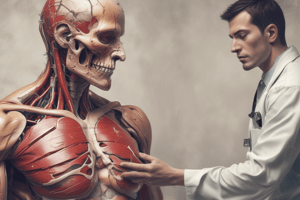Podcast
Questions and Answers
What is a common injury resulting from a direct blow to the chest wall?
What is a common injury resulting from a direct blow to the chest wall?
- Rib fracture (correct)
- Concussion
- Epidural hematoma
- Amputation
What is a possible symptom of a patient with a hemothorax?
What is a possible symptom of a patient with a hemothorax?
- Chest pain (correct)
- Tachypnea
- Seizures
- Altered mental status
Which of the following is a mechanism of injury for head trauma?
Which of the following is a mechanism of injury for head trauma?
- Direct blows to the extremities
- Deceleration injuries (correct)
- Compression of the chest cavity
- Falls from heights
What is a common presentation of a patient with an orthopedic injury?
What is a common presentation of a patient with an orthopedic injury?
What is a possible complication of a diaphragmatic injury?
What is a possible complication of a diaphragmatic injury?
What is a common injury resulting from a deceleration injury?
What is a common injury resulting from a deceleration injury?
Flashcards are hidden until you start studying
Study Notes
Blunt Trauma
Chest Trauma
- Mechanisms of injury:
- Direct blow to the chest wall
- Compression of the chest cavity
- Deceleration injuries (e.g., high-speed motor vehicle accidents)
- Common injuries:
- Rib fractures
- Hemothorax (bleeding into the chest cavity)
- Pneumothorax (collapsed lung)
- Cardiac contusions
- Diaphragmatic injuries
- Clinical presentation:
- Chest pain
- Shortness of breath
- Decreased breath sounds
- Tachycardia
- Hypotension
Head Trauma
- Mechanisms of injury:
- Direct blow to the head
- Deceleration injuries (e.g., falls, motor vehicle accidents)
- Penetrating trauma (e.g., gunshot wounds)
- Common injuries:
- Concussions
- Skull fractures
- Epidural hematomas
- Subdural hematomas
- Intraparenchymal hemorrhages
- Clinical presentation:
- Altered mental status
- Confusion
- Loss of consciousness
- Vomiting
- Seizures
Orthopedic Trauma
- Mechanisms of injury:
- Direct blows to the extremities
- Falls from heights
- Motor vehicle accidents
- Common injuries:
- Fractures (e.g., femur, tibia, fibula)
- Dislocations (e.g., shoulder, elbow, hip)
- Soft tissue injuries (e.g., ligament sprains, muscle strains)
- Amputations
- Clinical presentation:
- Pain
- Swelling
- Deformity
- Limited range of motion
- Neurological deficits (e.g., numbness, weakness)
Chest Trauma
- Direct blow to the chest wall, compression of the chest cavity, and deceleration injuries are common mechanisms of injury
- Rib fractures, hemothorax, pneumothorax, cardiac contusions, and diaphragmatic injuries are common injuries associated with chest trauma
- Clinical presentation includes chest pain, shortness of breath, decreased breath sounds, tachycardia, and hypotension
Head Trauma
- Direct blow to the head, deceleration injuries, and penetrating trauma are common mechanisms of injury
- Concussions, skull fractures, epidural hematomas, subdural hematomas, and intraparenchymal hemorrhages are common injuries associated with head trauma
- Clinical presentation includes altered mental status, confusion, loss of consciousness, vomiting, and seizures
Orthopedic Trauma
- Direct blows to the extremities, falls from heights, and motor vehicle accidents are common mechanisms of injury
- Fractures, dislocations, soft tissue injuries, and amputations are common injuries associated with orthopedic trauma
- Clinical presentation includes pain, swelling, deformity, limited range of motion, and neurological deficits such as numbness and weakness
Studying That Suits You
Use AI to generate personalized quizzes and flashcards to suit your learning preferences.




